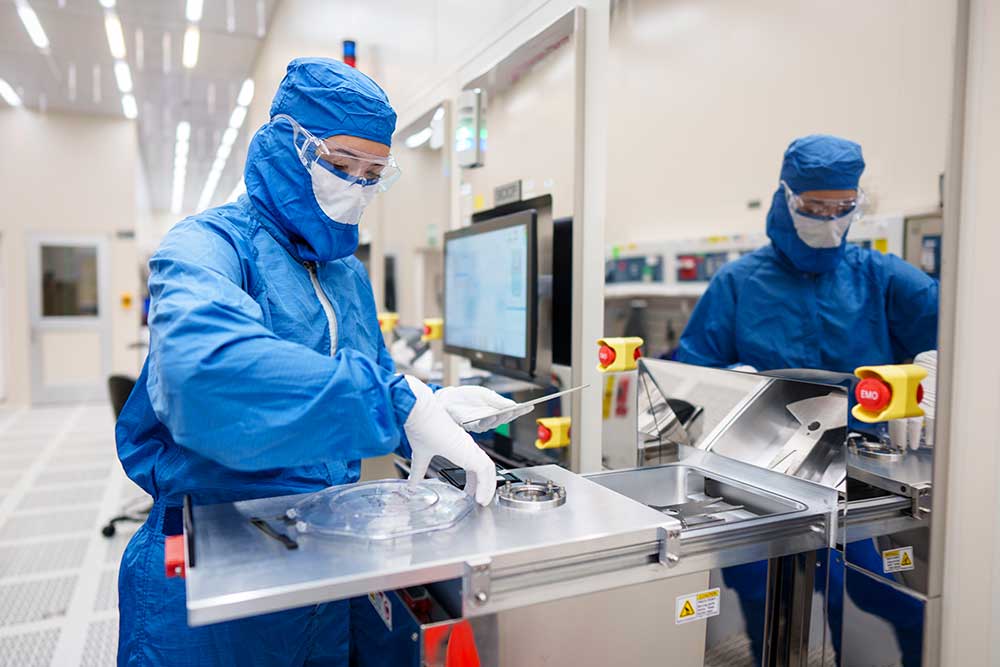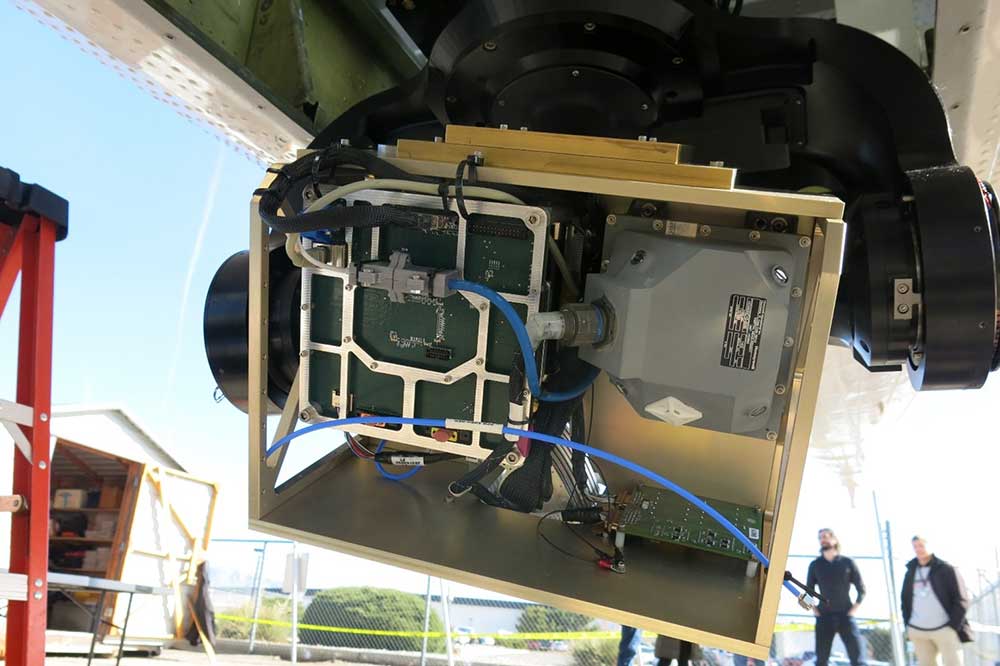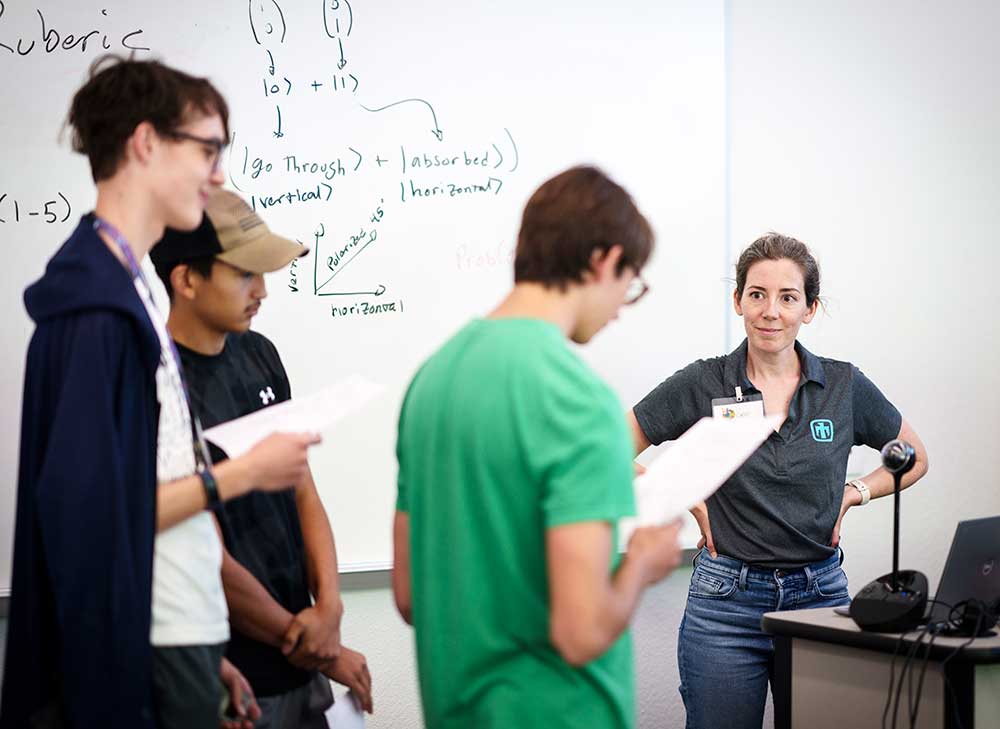
MESA celebrates milestone semiconductor deliveries
The Microsystems Engineering Science and Applications team successfully completed life-of-program deliveries for the W88 Alt 370 and B61-12 for silicon application-specific integrated circuits and compound semiconductor heterojunction bipolar transistor-based semiconductors. The heterojunction bipolar transistor team received an NNSA Defense Programs Award of Excellence in recognition of the largest single delivery of over 25,000 war reserve parts, the largest delivery in Sandia’s history. This achievement culminated in a record 41 consecutive on-time, quality-assured deliveries for this specific product line. • 2000, 5000, 7000

Industry-produced hypersonic glide body
Sandia proved it can act as mission integrator in a flight test for U.S. Navy’s Conventional Prompt Strike and U.S. Army’s Long Range Hypersonic Weapon programs. The successful stool-launch flight test met all mission objectives on time and under budget, with no safety incidents. The test was the first flight of the Sandia-designed, Dynetics-produced Block 1 of the Common-Hypersonic Glide Body and provided critical operational and flight test data that will benefit future U.S. hypersonic efforts. • 5000
AI-assisted tool supports Labs networks
The ATLAS team from the Human-Driven Data Science group has deployed a suite of AI applications powered by large language models on Sandia restricted and classified networks. These include AI microservices for data ingestion, a web application featuring retrieval augmented generation and robust authentication with metagroup-based access control. Early use cases span various labs, focusing on insights from complex information, AI design assistance, human-AI collaboration for workflow enhancement, knowledge management, program management, cyberassurance, materials research, smart factories, data analytics and supply chain risk mitigation. • 1000, 5000, 6000, 8000, 9000
NOMAD system breaks down plastics
A multidisciplinary Sandia team collaborated with Iowa State University to develop Novel Oxo-degradation for Macronutrients in Austere Deployments, an integrated chemical and biological system to break down plastics through thermochemical and biobased processes, ultimately converting them into a yeast-like paste. Implementing the system allows Sandians to investigate the production of chemicals and energy from variable waste materials for military forces, reducing dependency on supply chains for oils, lubricants, food and fuels, with potential benefits for military bases, landfills and space exploration. • 8000
Setting the standard in security excellence
The High Security Operations team excelled during a DOE Office of Enterprise Assessment Physical and Information Security Inspection. Key areas evaluated included program planning and management, personnel security, physical protection systems, information security and the technical security program of the Field Intelligence Elements. Many areas earned commendations for their advanced maturity, surpassing other Field Intelligence Elements. This achievement establishes Sandia as a leader in the nuclear security enterprise, and the DOE Office of Intelligence shared Sandia practices with other sites. • 5000

MESA delivery to Spectral Imaging Geolocating Hyper Temporal Sensor Program
Microsystems Engineering Science and Applications delivered two advanced imaging systems known as Hyper Temporal Sensor-Venus to a DOD partner for satellite payload integration. These systems are the first of their kind, showcasing image resolution, on-chip image analysis and high-speed imaging. They represent the most complex chip designs ever developed at Sandia, using semiconductor chips fabricated at MESA and a domestic foundry. The successful delivery was facilitated by microelectronics integration technologies and strategic collaborations with key external partners. • 2000, 5000, 7000
Sandia informs policymakers on emerging tech
The Emerging Disruptive Technology team provides timely and sound assessments on the pace and direction of developing technology trends that affect national security and economic issues. Some of Sandia’s most widely read and praised research addressed AI, biotechnologies and microelectronics. One analysis was briefed directly to the president, and many are routinely read by the National Security Council and the White House Office of Science and Technology Policy. • 1000, 3000, 4000, 5000, 6000, 8000
Southwest Summer Workshop
The Kachina program hosted its annual eight-week Southwest Summer Workshop, welcoming participants from throughout the intelligence community. The team successfully identified and delivered multiple novel capabilities to support national security missions. • 5000

Sounding rocket campaign success
The High Op Tempo for Hypersonics team recently completed its third successful flight test campaign at NASA’s Wallops Flight Facility in Virginia. The campaign supported U.S. Navy, Army and Missile Defense Agency programs, culminating in the launch of two sounding rockets carrying over 17 experiments. The team improved rocket performance, flying above Mach 8 for two minutes longer than predicted. Data from these flights is aiding technology maturation plans, enabling rapid development of new capabilities at lower cost for the DOD’s hypersonic capability. • 5000

Coherent tagging and tracking demonstration
The Office of the Undersecretary of Defense initiated an interagency acquisition with Sandia for the Joint Staff Warfighting Lab Incentive Fund project UR-IT. Sandia teams of radio frequency, electronics and radar experts collaborated with Navy and Air Force to establish requirements and develop prototypes using coherent synthetic aperture radar tag technology. The project demonstrated new operational capabilities for the partners in contested environments. Its deployment during the Gray Flag 2024 exercise at Naval Base Ventura County evaluated multidomain systems in maritime settings, enhancing tracking quality for tactically relevant ranges and platforms. • 5000
FIREWHEEL Emulytics tool open sourced
The process of making the FIREWHEEL Emulytics tool widely available and on Sandia’s GitHub site began in 2018 and required close collaboration between Sandia and the sponsor. Emulytics, coined by Sandia, aggregates a variety of tools to support workflows needed for rigorous cyber experimentation. FIREWHEEL is a virtualization, emulytics and system modeling tool that generates behavioral insights that deliver high-impact information to sponsors. • 5000
Most complex cyber-physical experiment in
DOE history
The WESTWORLD team developed and performed the most complex cyber-physical experiment in DOE history, resulting in otherwise undiscoverable insights into the ability of adversaries to alter U.S. critical energy infrastructure. The experiment, which was the capstone of a multiyear campaign exploring nation-state threats to U.S. infrastructure, capped 2.5 years of planning, research and development, and a series of increasingly challenging proof of concept and emulation tests drawing on expertise and capabilities from seven national laboratories. • 5000, 8000, 9000

HARPE completes first flight test
The High Altitude Radar Position Estimation team successfully completed HARPE’s first flight test on a Twin Otter aircraft. The critical milestone was the first demonstration of a radar-based position estimation concept with a legitimate path to use in a future nuclear deterrence system. The Air Force and Navy rely on Sandia to provide technical solutions that improve accuracy of advanced concept systems. This compact system based on the Labs’ Synthetic Aperture Radar seeks to improve overall system accuracy through improved positional awareness. • 5000
Counter-adversarial machine learning expansion
The chief AI officer of the DOE Office of Intelligence has begun expanding counter-adversarial machine learning methodologies to enhance security across the broader intelligence community. Sandia researchers have been instrumental in developing CAML methodologies and training. This initiative addresses various attack scenarios, including evade attacks that subtly mislead machine learning systems, subvert attacks that compromise model integrity through poisoned data, extract attacks that steal sensitive information and misuse attacks that exploit benign systems for malicious purposes, such as deep fakes. This approach aims to strengthen AI resilience and safeguard critical data and systems. • 1000, 5000, 8000

Elevate Quantum tech hub
In July 2024, Sandia joined with Elevate Quantum to form a quantum information science tech hub, one of 12 tech hubs chosen by the U.S. Economic Development Administration to drive U.S. leadership and economic success in quantum. Sandia and Elevate Quantum will establish a small-scale quantum fabrication facility for rapid prototyping and low-volume manufacturing of critical quantum technologies. Sandia will also launch programs to train the next-generation quantum workforce and kickstart the regional quantum innovation ecosystem. • 1000, 5000
Kachina exceeds technology transfer expectations
The Kachina portfolio surpassed its target for cybertechnology transitions, showcasing outstanding performance. These transitions play a crucial role in advancing sponsor missions and highlight Sandia’s ability to innovate, iterate and deliver cutting-edge technology. • 5000, 8000, 9000
MESA CORE
The Microsystems Engineering Science and Applications Comprehensive Operational Resource Environment went live. MESA CORE is an integrated software solution that revolutionizes the research, development and production missions at MESA and connects planning, manufacturing, inventory and costs across the MESA complex, consolidating systems and improving cost fidelity and consistency. • 5000, 9000, 10000